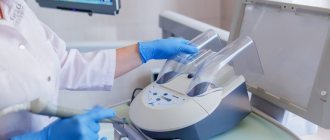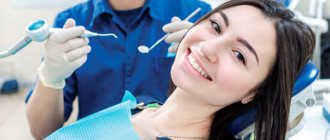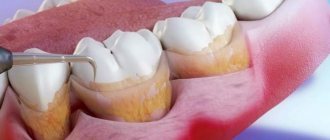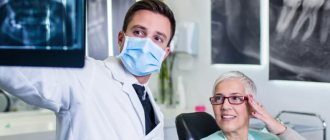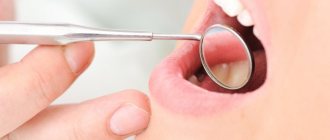Dear patients, we present to your attention a theoretical excursion into gum diseases, which occur in most cases, but unfortunately are very often detected in the later stages and as a result, aesthetics suffer or we lose teeth altogether. What is periodontium? The periodontium is a complex of closely interconnected tissues that surround the tooth. These include the gums, the jaw bone around the tooth, the ligament, and the cementum of the tooth. What functions do periodontal tissues perform? From the above, we understood that periodontal tissue is the “foundation” for teeth, which means it surrounds and holds the teeth, ensuring their fixation, regulates the chewing load, and performs protective and regenerative functions. Causes of periodontal diseases .
The main reason for the development of periodontal diseases is poor oral hygiene and the presence of dental plaque. In the absence of proper gum care and treatment, the structure of the “foundation” is destroyed and is largely irreversible. Pathogenic microorganisms, penetrating deep under the gum, destroy the ligament and bone tissue. As a result, a space is formed between the gums and teeth - periodontal pockets, where optimal conditions are created for the growth of bacteria, which provokes the dissolution of bone tissue and subsequently leads to loosening and tooth loss.
Other reasons:
- diabetes
- immunodeficiencies
- diseases of the blood system, etc., which have the so-called “periodontal syndrome”.
The most common diseases of periodontal tissues:
- Gingivitis is an inflammation of the gums surrounding the tooth, accompanied by unpleasant sensations such as bleeding, swelling of the gums, pain, and is often detected during brushing. The first harbinger of severe forms of periodontal disease.
- Periodontitis is an inflammation of infectious origin that affects bone tissue.
Periodontal disease is a consequence of changes in the functioning of the whole organism: endocrine and metabolic disorders, diseases of the cardiovascular system, and a hereditary factor cannot be excluded. The blood supply to the gums is disrupted, as a result of which the gum “retracts” and the tooth root is exposed. Tooth mobility occurs extremely rarely.
Treatment of periodontal diseases.
The first point in the treatment of periodontal diseases is professional hygiene, then, based on the diagnostic results, the doctor prescribes individual comprehensive treatment . The latter can consist of several types of intervention, which is aimed at eliminating the cause of the disease, the infectious agent, and restoring lost tissue.
Now let's get started!!!!
Success in the treatment of periodontal diseases is based on strict adherence to the main ALGORITHM:
-professional hygiene and training in individual hygiene (selection of tools, hygiene products)!!! Depending on the degree of damage and forms of periodontal disease, the following methods are selected:
I. Conservative treatment
(all forms of gingivitis, initial stage of periodontitis)
— professional hygiene; - drug treatment; — training in personal hygiene.
Now let’s take a closer look at the treatment methods... Professional hygiene is a whole complex of measures based on 3 main stages:
- Removing dental plaque;
- Grinding and polishing;
- Fluorization is the strengthening of enamel.
Initially, stones and hard plaque are “beaten off” from the tooth and from under the gums using an ultrasonic nozzle (due to the vibration of thin metal plates when a low-voltage electrical signal is applied.) or special hand tools. This procedure, depending on the individual sensitivity of the patient, can be performed both under the influence of local anesthesia and without it. And it all ends with coating the teeth with fluoride varnish.
Periodontal diseases. Causes
- Plaque . The main cause of gingivitis is improper or infrequent oral hygiene. If you brush your teeth too infrequently or incorrectly, plaque will form on your teeth, which consists of food debris and bacteria. Despite the fact that plaque adheres tightly to the surface of the tooth, it can be easily removed with a brush. But if you don’t get rid of it in time, it will harden over time and turn into tartar. As a result, an inflammatory process will appear that can no longer be dealt with at home.
- One of the main causes of periodontal disease is smoking , as it promotes the deposition of plaque and the formation of tartar, disrupts the body's immune response, and creates favorable conditions for harmful bacteria that are dangerous to periodontal disease.
- Genetic factors that affect the body's ability to fight bacteria.
- Mechanical damage to the gums.
- Various medications . For example, antibiotics.
- Vitamin deficiency (mainly lack of vitamins B and C).
- Age . In old age, immunity, which helps fight periodontal infections, decreases.
- Systemic diseases also affect periodontal health. For example, diabetes, osteoporosis, AIDS, Down syndrome. Frequent vomiting also leads to periodontal disease. As a result of vomiting, a lot of acid appears in the mouth, which leads to gum disease.
- Poorly performed previous dental treatment . For example: - fillings that overload periodontal tissues; - poorly executed prosthetic structures.
- Incorrect structure of the oral cavity : - incorrect bite - incorrect attachment of the frenulum of the lips, tongue, cheeks. Bruxism (teeth grinding) also leads to periodontal disease.
II - Surgical treatment
1. Gingival surgery (all types of operations on periodontal tissues in the area of free and attached parts of the gum): • curettage; • gingivotomy; • gingivectomy; • patchwork operations that correct the gum edge; • surgical techniques using electrocoagulation, cryodestruction, laser and radiocoagulation; • gingivoplasty.
2. Flap operations, etc.
Recommendations from your dentist!!! From all of the above, the final stage is:
Timely preventive examination and professional oral hygiene: periodic removal of dental plaque - once every 6 months. The most thorough oral hygiene, the use of antiseptic and antibacterial rinses by the patients themselves after an active treatment course leads to a positive result.
The main link in adequate individual oral hygiene is proper brushing of teeth by the patient himself using various hygiene products (toothbrushes, toothpastes and gels, brushes, floss, rinses, chewing gum, etc.).
Teeth brushing sequence:
Let's conditionally divide the dentition into 6 sections - left, right, front above and below. Teeth brushing is carried out with open dentition. The brush is positioned at an angle of 45 degrees to the tooth surface. They begin to brush their teeth from the buccal surface of the upper jaw on the left, where they perform 10 sweeping movements with the brush, after which they gradually move through all other sections (10 movements for each section of the oral cavity). After this, they clean the palatal surface of the upper teeth, passing through the segments from left to right. , making 10 sweeping movements on each segment. The next step in brushing your teeth is to clean their chewing surface. Cleaning is carried out by scraping movements along the chewing surface of the teeth in the direction from the mouth. It is necessary to make 10-15 movements on each side. When cleaning the palatal surface of the upper incisors and the lingual surface of the lower incisors, the brush is positioned perpendicular to the dentition. The cleaning procedure should end with a massage of the gums, which is carried out with closed dentition using circular movements of the toothbrush, grasping the teeth and gums, moving from left to right.
Modern aspects of the prevention of periodontal diseases
L. N. Kazarina, L. V. Vdovina. Department of Propaedeutic Dentistry, Nizhny Novgorod State Medical Academy
“To prevent the “smile of the 21st century” from becoming completely toothless and transforming into the “edentia of the 21st century,” we need to study oral hygiene, learn it ourselves and teach it to our patients, so that the moment does not come when there is nothing left to treat and no one to treat.” U. B. Ulitovsky, 2000
Relevance of the problem
Issues of prevention of periodontal diseases constitute an important section of dentistry. The analysis shows a high prevalence of periodontal disease, which increases significantly with age. 50% of 12-year-old children need training in oral hygiene rules, 20% need professional hygiene. 86% of people aged 35-44 years need periodontal care, including surgical treatment. The prevalence of periodontal diseases in Russia, depending on age, ranges from 48.2% (at 12 years old) to 86.2% (at 44 years old), and by 60-65 years old it reaches 100%. According to the results of numerous epidemiological studies by domestic and foreign authors, the most common periodontal pathology at a young age is gingivitis, after 30 years - periodontitis.
Research results show that even a mild degree of periodontal disease in children, in the absence of prevention, becomes quite severe in adults with the need for therapeutic, surgical and orthopedic treatment.
Numerous studies [Alimsky A.V., 1989; 2000; Grudyanov A.I., 1994; Barer G. M., 1995; Borisova E. N., 2001; Ivanov V.F., 1998, 2001; Beck JD, Slade GD, 1996; Gjermo PE, 1998, etc.] showed that only 12% of people have healthy periodontium, 53% have initial inflammatory changes, 23% have initial destructive changes, and 12% have moderate and severe lesions: in age groups 35 -44, 45-54, 55 years and older, the number of people with initial periodontal changes progressively decreases (26-15%) with a simultaneous increase in moderate and severe changes - up to 75%.
One of the main reasons for the development of periodontal diseases are local factors. With gingivitis, more microorganisms and a higher percentage of gram-negative bacteria are detected in dental plaque than in the plaque of a person with intact periodontium.
Dental plaque has a complex effect on periodontal tissue:
- toxic due to waste products of microorganisms;
- mechanical as a result of pressure on the gingival margin.
As bacteria and their metabolic products interact with periodontal tissues, inflammation and destruction develop.
The greatest importance in the development of this process is given to Str. Sanguis, Actinomyces viscosus, etc.
Local risk factors include: excessive consumption of soft foods, poor hygiene, decreased saliva secretion, overhanging edges of fillings, the presence of orthodontic appliances, anomalies of the vestibule of the oral cavity and the location of teeth, mechanical damage, chemical and physical injuries, errors in orthopedic and orthodontic treatment.
Common risk factors include: endocrine diseases, neurosomatic diseases, tuberculosis, metabolic disorders, hypovitaminosis.
Currently, knowledge of the etiology of the disease, risk factors and their timely elimination makes it possible to prevent the development of periodontal diseases or reduce the severity of pathological changes.
An important aspect in the occurrence of periodontal pathology is the metabolism of vitamins in the body. Metabolically essential food components must be constantly supplied to the body from the outside.
The oral mucosa is very sensitive to a deficiency of essential nutrients, as it is a target that undergoes structural changes when there is a deficiency of nutrients. The most pronounced changes occur in soft tissues, where connective tissue degeneration, slower wound healing, and atrophy of the tongue epithelium are observed. It is necessary to regularly supply the body with vitamins that are of great importance in ensuring its normal functioning.
For example, the pathological effect of a lack of vitamin C is expressed in damage to the walls of blood vessels in places of greatest tension, as collagen synthesis is disrupted. Its deficiency reduces the adaptive reactions of the periodontium, in particular the gums as a very important barrier tissue complex, contributes to disruption of the process of formation and formation of collagen fibers, tissues are loosened, the permeability of intercellular layers and capillaries increases, and mature collagen structures are subject to destruction.
Vitamin A has an anti-inflammatory effect and plays a major role in the epithelization of the gums, and a deficiency leads to a decrease in barrier function due to alteration of the gingival margin. Vitamin B influences the trophism of periodontal tissues, contributing to the manifestation of dystrophic processes. A lack of vitamin B leads to increased sensitivity of the oral mucosa to damaging factors and the development of inflammatory changes in soft tissues. Vitamin E increases the permeability of the vascular wall, and its deficiency leads to bleeding gums and the release of purulent contents from periodontal pockets due to increased migration of leukocytes into the bloodstream.
With E-vitaminosis, gum inflammation develops due to changes in the structure of collagen and elastic fibers.
Vitamin D deficiency leads to changes in calcium metabolism during bone formation (jaw resorption).
Vitamin K is necessary for the formation of prothrombin in the liver; with its deficiency, bleeding of the gingival papillae occurs. Vitamin P ensures the integrity of capillary walls, preventing their fragility. Vitamin PP deficiency causes dermatitis, glossitis, gingivitis and stomatitis.
With a lack of folic acid, anemia develops with characteristic changes in the oral cavity (necrosis of periodontal tissue).
The role of microtrauma in the etiology of periodontal diseases is also known. Periodontal damage can be caused by chronic autotrauma - the actions of the patient himself. A special role here is played by smoking, which causes a number of significant pathological changes in periodontal tissues, in particular, it suppresses local immunity and tissue regeneration. Nicotine causes prolonged spasm of peripheral vessels, resulting in reduced oxygenation of periodontal tissue. Therefore, smoking cessation is strongly recommended as a preventative measure.
Research shows that patients suffering from periodontal disease have a 2-3 times higher risk of heart attack and stroke. It is also known that pregnant women with severe periodontitis are 8 times more likely to give birth prematurely or have a risk of miscarriage. Violation of the act of chewing leads to dysfunction of the entire digestive system, speech disorders and cosmetic defects occur. Currently, another rather serious factor has emerged that provokes the development of various pathologies (with gum fibromatosis, hypertrophic gingivitis, epulis, interradicular granuloma): the use of anabolic steroids by young people when engaging in bodybuilding and professional strength sports. The doctor’s capabilities here are modest: clarification and advice.
What really leads to a positive result in such cases? Maximum thorough oral hygiene, the use of effective antiseptic and antibacterial rinses by the patients themselves after an active treatment course. Modern view on the prevention of periodontal diseases. The most important component in the overall complex of preventive measures is rational oral hygiene. Proper oral care using modern hygiene products (toothbrushes, pastes, rinses, flosses and irrigators). The dentist’s task is to choose the right products for each patient. On the part of the dentist, preventive measures should also be aimed at eliminating traumatic occlusion and stabilizing the microcircular bed.
The neglect of periodontal pathology in patients is associated with their inattention to the condition of the oral cavity and necessitates their systematic and comprehensive treatment. These patients prefer to be treated in public clinics. This is important for a rational marketing strategy of public clinics, because The presence of strong demand with little marketing effort creates the opportunity to plan for the further development of various types of periodontal services that will be in demand. The weakest link in the implementation of measures for the primary prevention of major dental diseases is the hygienic education of the population and sanitary educational work [Kondratov A.I., 1990; Khamadeeva A.M., 2000].
Hygienic education of the population needs optimization and intensification.
Today, oral hygiene should be taught not only to children, but also to their parents. Only comprehensive dental educational work will activate auditory and visual motivation, improve hygiene skills and theoretical knowledge about dental health.
Optimization and intensification of oral hygiene consists of the targeted use of motivational methods of hygienic education, professional oral hygiene, and the use of clinically and cost-effective modern medications. Motivation plays an important role in increasing functional literacy, mastering manual skills and abilities, theoretical knowledge about a healthy oral cavity and a healthy lifestyle.
To optimize, it is rational to use motivational methods of oral hygiene. First of all, it is necessary to create a theoretical foundation, strive to develop cognitive activity among the population, arouse interest and desire to receive information, as well as instill manual skills, maintain and improve hygienic knowledge and skills. But, unfortunately, patients have insufficient understanding of oral hygiene as the main preventive and therapeutic procedure, and neither health authorities, nor dental services, nor cities are ready to implement prevention programs, despite the fact that an epidemiological survey of the population has been carried out, programs prevention measures have been developed and approved. However, they do not “work” fully, since not all cities have executors of this initiative. In the last 20-30 years, the introduction of preventive programs in developed countries of the world has led to a significant (up to 80%) reduction in the prevalence and intensity of periodontal diseases.
The experience of many countries has shown that a simple quantitative increase in personnel, funding and material support for the dental service is insufficient to change the current situation in reducing the level of dental morbidity [Leontiev V.K., 2000; Maksimovskaya L.M., 2000].
Low sanitary culture and lack of motivation of the population for the prevention of dental diseases and oral hygiene characterize the dental status of modern man. It is possible to increase the dental level of health with minimal economic costs only through mass preventive work, using all available methods and means of dental educational activities.
Active dental educational work, the creation and implementation of a comprehensive prevention program can and should be carried out by dentists and hygienists. This proposal undoubtedly requires a revision of the staffing table, a complete division of powers between dentists, hygienists involved in preventive work, and restorative doctors. This will allow us to optimize and intensify etiopathogenetic treatment and preventive measures aimed at improving the health of the oral cavity. A revision of the schedule and the addition of dentists and dental hygienists to the staff of municipal clinics will help resolve this problem.
The system for the prevention of periodontal diseases provides for primary, secondary and tertiary prevention, taking into account age, professional, and biochemical characteristics.
Primary prevention is the main stage in the prevention of periodontal disease. The set of measures involves, first of all, the education of hygienic skills among the population, balanced nutrition, regular visits to the dentist in order to identify risk factors such as occlusion, the presence of plaque, deformation of the vestibule of the oral cavity, etc., rational feeding of the child.
Secondary prevention is aimed at eliminating identified periodontal factors using surgical, therapeutic and orthopedic methods, X-ray examination, sanitation of the oral cavity and hygienic measures.
Tertiary prevention involves complete or partial relief of the inflammatory-dystrophic process, preventing the disease from progressing to a more severe form, preventing exacerbations, and restoring the function of the masticatory apparatus.
Thus, tertiary prevention includes the entire scope of dental care with a predominance of orthopedic treatment.
Prevention of periodontal disease consists of the following steps:
- Elimination of risk factors: removal of dental plaque and plaque;
- restoration of occlusion (selective grinding, orthopedic measures);
- correction of the vestibule of the oral cavity (small vestibule, shortened frenulum);
- restoration of the trophic function of periodontal tissues;
- fight against bad habits.
Issues resolved at the national level:
- Sanitation of the oral cavity in children, adolescents, and pregnant women.
- Rational nutrition in kindergartens and schools.
- Organization of hygiene rooms, treatment of periodontal pathology.
- Production of oral care products.
Such pieces of prevention as mandatory sanitation of the oral cavity in children and adolescents, pregnant women, and preventive examinations are, unfortunately, only partially carried out.
Age-related prevention of periodontal disease should begin in the prenatal period and include a balanced diet for the pregnant woman, limiting medications, especially antibiotics such as tetracycline, and corticosteroids, due to the risk of congenital deformities of the maxillofacial region. During the period of active function of the dental system (20-40 years), when periodontal pathology fully manifests itself, active preventive intervention is required. The period over 40 years is characterized by the development of sclerotic phenomena in periodontal tissues and a decrease in the body’s protective capabilities. Patients under the age of 45 with compensated and decompensated forms of periodontal disease are mainly subject to clinical observation.
An important part of the primary prevention of periodontal disease is a set of hygienic measures, in particular regular brushing of teeth, therefore the most important part of preventive measures is hygienic education of the population, dental educational work, teaching children and adults the rules of oral hygiene.
Professional oral hygiene is the most important stage in the prevention and complex treatment of periodontal diseases and hard dental tissues. During its existence, it has developed into a stage of treatment, without which neither aesthetic restoration, nor treatment of inflammatory periodontal diseases, nor implantation, nor orthopedic, nor orthodontic treatment can be done [Ulitovsky S. B., 2000; Kuzmina E.M., 2001]. Professional hygiene is carried out to a large group of the population - children, adolescents and adults.
As a dental procedure, professional hygiene has become widespread, and is carried out by dentists, periodontists, and dental hygienists [Ulitovsky S. B. et al., 2000]. Regardless of the form and stage of periodontal pathology, removal of mineralized dental plaque is the first stage of local treatment [Borovsky E.V. et al., 2003; Pakhomov G. N., 1982; Cohen ES, 1994; Ulitovsky S. B. et al., 2000; Maksimovsky Yu. M. et al., 2002; Grudyanov A.I., 2004].
Currently, to remove mineralized dental plaque, hand tools (metal, plastic, Teflon) and electric ones are used - ultrasonic (magnetostrictive and piezoelectric, Vector-system) and sonic.
It has been proven that sound and ultrasonic vibrations have a pronounced physiological effect on the tissues of the human body, including the condition of blood vessels [Khorbenko I. G., 1978; Mikhailova R.I., 1985; Sokolov D.V. et al., 1997; Miller E. et al., 1989].
The blood supply to the dental pulp has a number of structural and functional features, determined by the location of the pulp in a “chamber” with rigid walls, as well as the special structure of its vessels [Gavrilov E.I., 1969].
According to Doppler ultrasound data, in patients with the initial stages of periodontal disease, the blood flow velocity in both the vessels of the dental pulp and in the gum is reduced to 16.2% compared to the indicators in individuals with intact periodontium.
The electrical excitability of the dental pulp in patients with intact periodontium and with periodontal diseases in the early stages before and after professional oral hygiene using electric scalers increases by an average of 5%.
When removing dental plaque using both ultrasonic and sonic scalers, a change in the functional state of the microvasculature of the periodontal bed and dental pulp occurs in an average of 94.3% of cases, therefore, the appointment of diagnostic procedures immediately (within 3 hours) after professional oral hygiene inappropriate. An ultrasonic scaler has the greatest damaging effect on the surface of hard tooth tissues compared to a sonic scaler and a hand-held metal instrument.
Speaking about the prevention of periodontal disease, patients should be reminded that this is, first of all, a chronic source of infection that constantly enters the bloodstream, a source of allergization of the body. Periodontal disease has recently received renewed attention from researchers due to possible links with other pathologies, such as cardiovascular disease, low birth weight of newborns and premature birth. Therefore, dentists make a huge contribution to the overall health of the nation. They not only provide treatment and education to patients, but can also play an important role in the detection, early diagnosis of various diseases such as diabetes, HIV/AIDS, oral cancer and others.
How is periodontal disease diagnosed?
Initially, a medical history (anamnesis) is carefully collected. Careful collection allows us to determine risk factors and predict the course of the disease. This is followed by an examination of the oral cavity. One of the main examination methods is probing the periodontal pocket of each tooth; here the latest technologies come to the aid of the doctor. Computer diagnostics using the Florida Probe device.
The Florida Probe system is a modern software and diagnostic complex that allows you to conduct an accurate study of the condition of the patient’s gums (periodontal) and record the results in the form of an electronic periodontogram.
The obtained accurate data is entered into an electronic periodontogram and, in combination with an x-ray examination, allows the doctor to make an accurate diagnosis and prescribe treatment, after which a repeat periodontogram can be drawn up and the achieved result can be assessed.
A mandatory diagnostic method is x-ray examination. Our center performs X-ray examinations using a Galileos computed tomograph.
What is periodontics?
Periodontology is a branch of dentistry that deals with the treatment and prevention of periodontal diseases.
Periodontal diseases are widespread among the population. According to the World Health Organization in Russia, about 85% of the adult population and up to 65% of children have signs of periodontal disease. The particular danger of periodontal disease lies in the fact that the onset and first stages of the disease can be asymptomatic. The most common reasons for treatment in periodontology are gingivitis, periodontitis and periodontal disease.
The treatment, prevention and diagnosis of periodontal diseases is carried out by a periodontist. A periodontist is a dentist who has completed a special training course.
You need to consult a periodontist if you have the following symptoms:
- formation of plaque and tartar on teeth.
- bad breath;
- bleeding gums when brushing teeth;
- exposure of the neck of the teeth;
- mobility of teeth, change in their position;
What is gingivitis?
Gingivitis is an inflammation of the gums caused by the adverse effects of local and general factors (it is the initial stage of periodontitis), which occurs without compromising the integrity of the periodontal attachment and the manifestation of destructive processes in other parts of the periodontium. The gums turn red, swell and begin to bleed slightly. Pain, swelling, and bad breath may occur. Usually the inflammation begins between the teeth. If the cause of the disease is not eliminated, then acute gingivitis becomes chronic, which does not go away on its own without treatment.
What is periodontitis?
Periodontitis is an inflammation of periodontal tissues, characterized by destruction of the periodontal ligaments and alveolar bone.
If treatment is not carried out in time, gingivitis turns into periodontitis. Periodontitis can be acute or chronic. In a chronic process, pain and swelling are mild. The amount of soft plaque and tartar increases, the bad breath increases, the gums begin to recede, exposing the neck of the tooth, and teeth become sensitive to temperature stimuli. Then, at first, imperceptible but quickly increasing tooth mobility appears. Suppuration of periodontal pockets is often observed.

